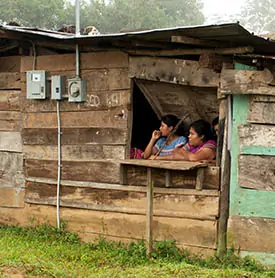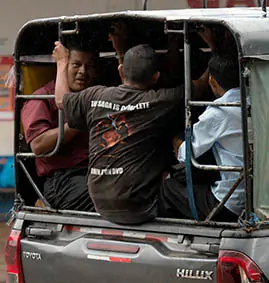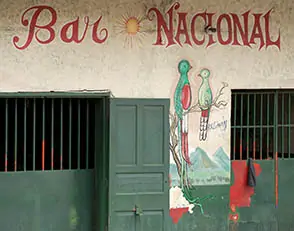Central America Travel Narrative Story: Skirting Panama's Ngäbe-Bugle Comarca
Story and photography by Ray Waddington.
Click/tap an image to begin a captioned slideshow (best viewed on a modern, wide-gamut display) and, where available, stock licensing information.

 Panama has a handful of comarcas — partially autonomous regions established in areas where its indigenous people have
traditionally lived. In the west of the country the Ngäbe-Bugle comarca was established in 1997 as the region for the
Ngäbe and Bugle peoples, who, combined, form the largest indigenous population of the country. Around 150,000 of them live there.
Panama has a handful of comarcas — partially autonomous regions established in areas where its indigenous people have
traditionally lived. In the west of the country the Ngäbe-Bugle comarca was established in 1997 as the region for the
Ngäbe and Bugle peoples, who, combined, form the largest indigenous population of the country. Around 150,000 of them live there.
Researching a future assignment, I recently spent time inside the comarca. But given how inaccessible it is (unless you speak one or both languages, have a local guide and can hike for hours or have a horse), I also spent a lot of time on its outskirts.
 I was staying in Santa Fe, Veraguas Province, a small town that is slowly becoming a tourism center. A twice-daily local bus, that
few people ride, heads west for about twenty kilometers until it reaches the tiny hamlet of Guabal and can go no further because the
road ends — or at least it did when I was there. Today it is being furthered and will, in a few years, cut through the
comarca to reach Panama's north coast.
I was staying in Santa Fe, Veraguas Province, a small town that is slowly becoming a tourism center. A twice-daily local bus, that
few people ride, heads west for about twenty kilometers until it reaches the tiny hamlet of Guabal and can go no further because the
road ends — or at least it did when I was there. Today it is being furthered and will, in a few years, cut through the
comarca to reach Panama's north coast.
 There's little to do in Guabal except marvel at the scenery, chill out to the laid-back pace of life and climb to the top of the hill
to view the wilderness that is the eastern part of the comarca. Walking away from the center I was surprised to find a mission.
The Centro Misionero Santa Laura Montoya ministers to the Ngäbe and Bugle
There's little to do in Guabal except marvel at the scenery, chill out to the laid-back pace of life and climb to the top of the hill
to view the wilderness that is the eastern part of the comarca. Walking away from the center I was surprised to find a mission.
The Centro Misionero Santa Laura Montoya ministers to the Ngäbe and Bugle
 as well as providing shelter to those
who leave the comarca temporarily to interact with mainstream society. Most of Panama's indigenous people have already been
converted to Catholicism.
as well as providing shelter to those
who leave the comarca temporarily to interact with mainstream society. Most of Panama's indigenous people have already been
converted to Catholicism.
 A few days later I based myself in Las Lajas, Chiriquí Province. There had just been a major hurricane in eastern Central America.
Even though a paved road goes into the comarca, the conditions were so bad that I couldn't find a guide or a taxi willing to take
me there. Providence intervened in the form of my guesthouse owner's friend who had a 4x4. I spent what would be my only day inside the
comarca under intermittent rain.
A few days later I based myself in Las Lajas, Chiriquí Province. There had just been a major hurricane in eastern Central America.
Even though a paved road goes into the comarca, the conditions were so bad that I couldn't find a guide or a taxi willing to take
me there. Providence intervened in the form of my guesthouse owner's friend who had a 4x4. I spent what would be my only day inside the
comarca under intermittent rain.
In the first village we visited there was a festival underway. I never got a clear answer on what was being celebrated. Answers ranged from a mass school graduation ceremony to an independence day parade. But it must have been important because there was a huge procession of marching bands with so many school-aged children that some must have come to the village from outlying communities. They seemed oblivious to the rain.
 Not so long ago the scene would have been different in this and many other villages in this part of the comarca. Much further
in than I was — but accessed by the same road — lies the Cerro Colorado copper mine. Although the indigenous inhabitants
control, in theory, the exploitation of resources within the comarca, they have not benefited from this mine. Despite promises
from different Panamanian administrations, the economic benefit has gone to the government and foreign investors while the legacy of
pollution has remained within the comarca. The situation led to violence, even fatalities, a few years ago as the Ngäbe
and Bugle mobilized in a series of protests. The situation is still not resolved.
Not so long ago the scene would have been different in this and many other villages in this part of the comarca. Much further
in than I was — but accessed by the same road — lies the Cerro Colorado copper mine. Although the indigenous inhabitants
control, in theory, the exploitation of resources within the comarca, they have not benefited from this mine. Despite promises
from different Panamanian administrations, the economic benefit has gone to the government and foreign investors while the legacy of
pollution has remained within the comarca. The situation led to violence, even fatalities, a few years ago as the Ngäbe
and Bugle mobilized in a series of protests. The situation is still not resolved.
But on this day the villagers had put that issue aside. As band after band of schoolchildren marched along the road, each was cheered
by the adults who outnumbered them. Most people in this and all Ngäbe and Bugle communities live a simple life based mainly on
farming.

 They are mostly economically poor compared to mainstream Panama, yet they displayed an unmistakable pride that day in their ability to
put on such a spectacle.
They are mostly economically poor compared to mainstream Panama, yet they displayed an unmistakable pride that day in their ability to
put on such a spectacle.
This was far from a typical day in this village or any other. I did not know that this event was taking place when I decided to try to
visit the comarca that day. I often seem to be luckier than many at stumbling across such events by chance. Yet I got a sense
that the community bonding I was observing and the pride in their people's heritage that was on display were not uncommon to these people.

Daily life is, of course, much different. For most of the children it revolves around school — although many do not progress all the way to graduating high school. But once school is out, as well as on weekends, most of these same children will be seen helping their family by working on the land or, if older, looking after younger siblings or cousins while the adults go about making a living. The road supports year-round travel when reliable transportation is available and just beyond the southern boundary of the comarca is the Pan-American Highway. For these reasons the Ngäbe and Bugle who live in this part are more geographically mobile and have greater wage labor opportunities.
 The next day I traveled to Tole — this time without a guide. Tole lies east of Las Lajas and just south of the comarca boundary.
It is a very small town. Here, the road into the comarca is not paved. I'd been told there were no accommodation options in Tole
unless I could convince someone to let me stay in their house. While that turned out not to be correct, this first visit would be for a few
hours only.
The next day I traveled to Tole — this time without a guide. Tole lies east of Las Lajas and just south of the comarca boundary.
It is a very small town. Here, the road into the comarca is not paved. I'd been told there were no accommodation options in Tole
unless I could convince someone to let me stay in their house. While that turned out not to be correct, this first visit would be for a few
hours only.

The rain left over from the hurricane was still pretty incessant. Nonetheless, Tole was busy. Being a crossroads for people traveling to and
from their villages inside the comarca, and others continuing to other parts of Panama, Tole is a de facto commercial center.
Onward travel north is by unscheduled pickup truck ascending and descending mountainous dirt roads. There was not enough time for me to take
the journey and also guarantee making it back to Las Lajas by nightfall — even though onward travel south and west is by scheduled bus
on paved roads.
 Still, there was enough to do in Tole to keep me occupied for a few hours.
Still, there was enough to do in Tole to keep me occupied for a few hours.
Despite the rain there were a few stalls set up in the outdoor market where everything from shoes to mobile phones were available. Here, as well as in the few stores that I entered, trade was brisk. Inside the comarca commerce is based strictly on a cash economy. Since very few indigenous people are in a position to secure credit, that is also the case outside the comarca for the Ngäbe and Bugle.
At times the rain was too heavy for me to continue my walking so I often had to dash to the nearest shelter and stay there until it slowed. During one such break I was sheltering opposite a bank. We probably take it for granted by now that we can visit an ATM when we need money, but the sight of this lady visiting a cajero automático to withdraw money was interesting for two reasons. First, it is unusual for these people to have a bank account at all; second, she probably journeyed many kilometers to be able to do this.
In this part of Panama indigenous people are also impacted by development. Barro Blanco is the name of a dam that has been constructed near Tole
 for a hydroelectric project.
The local Ngäbe residents have desperately opposed it for the last decade. It was test-flooded last summer with no warning given to
the hundreds of people whose livelihood was decimated by the swelling of the Tabasará River. According to the official environmental
impact study those same people do not exist! As of early May, 2017, the commercial operation of the project has been approved
for a hydroelectric project.
The local Ngäbe residents have desperately opposed it for the last decade. It was test-flooded last summer with no warning given to
the hundreds of people whose livelihood was decimated by the swelling of the Tabasará River. According to the official environmental
impact study those same people do not exist! As of early May, 2017, the commercial operation of the project has been approved
 and should begin in a matter of days.
and should begin in a matter of days.
The final stop on my self-styled mini tour was Boquete, also in Chiriquí Province. The core of this town is still very small since it
is surrounded by hills in all directions. Yet it has become a haven for expat and retired gringos,
as well as a "must-see" stop on the gringo tourism circuit.
 This has pushed land and property prices well beyond the means of most Panamanians.
This has pushed land and property prices well beyond the means of most Panamanians.
 This new gringo house is about fifteen minutes from the center, sits on perhaps seven hectares (seventeen acres) and would sell for about US$ 2 million.
This new gringo house is about fifteen minutes from the center, sits on perhaps seven hectares (seventeen acres) and would sell for about US$ 2 million.
The economy in Boquete is booming due to the influx of foreign money. Since the surrounding land is fertile, farming opens up wage labor
opportunities for the Ngäbe and Bugle. There is no direct transport to the comarca from here, so the laborers walk for many
hours and stay in temporary
 accommodation for weeks, even months at a time.
accommodation for weeks, even months at a time.
 Many bring their family with them.
Many bring their family with them.
Conditions for these migrant workers are a far cry from the luxury enjoyed by the gringos. The accommodation is as basic as imaginable. There is no electricity or running water this far from town. While some leave their children behind with grandparents or other relatives or neighbors, the children who do accompany them mainly drop out of school. Even the very young can often be seen helping on the farms, albeit engaged in light labor only.
It should not surprise us to learn that in such harsh conditions drug and alcohol abuse among men — and increasingly among women
— is rampant.
 There are two kinds of bar in Boquete and I was advised, for my safety, not to visit any of those patronized by the
Ngäbe and Bugle.
I ignored that advice. One place in particular in the center of town, Bar Nacional, is infamous. It was closed when I was there
There are two kinds of bar in Boquete and I was advised, for my safety, not to visit any of those patronized by the
Ngäbe and Bugle.
I ignored that advice. One place in particular in the center of town, Bar Nacional, is infamous. It was closed when I was there
 (probably because it was midday, Friday, which is pay day). But, in some other bars, locals confirmed to me that Bar Nacional is
often the starting place of brutal fights. While there is nothing interesting about alcohol-induced fighting among young men, this is different.
(probably because it was midday, Friday, which is pay day). But, in some other bars, locals confirmed to me that Bar Nacional is
often the starting place of brutal fights. While there is nothing interesting about alcohol-induced fighting among young men, this is different.
In the opening of The Mayor of Casterbridge Michael Henchard gets drunk and sells his wife and daughter. While Mayor is a purely fictional novel, there are anecdotal accounts of similar events at Bar Nacional and other bars in the area. Reports differ in their descriptions, but some suggest that drunk men challenge other drunk men to a duel for the right to win their wife/partner/girlfriend/children.
There are enough accounts of this bizarre ritual to warrant a field study by trained social anthropologists. (If such a study has already been undertaken, I have been unable to find it.) My own, informal research in Boquete, combined with research I conducted before and after visiting the area, suggests that there are cases where this does happen. If that is true we should be concerned for the mental health of the children being impacted. And so should the Ngäbe and Bugle adults who engage in the ritual.
Photography copyright © 1999 -
2025,
Ray Waddington. All rights reserved.
Text copyright © 1999 -
2025,
The Peoples of the World Foundation. All rights reserved.
Waddington, R., (2017) Skirting Panama's Ngäbe-Bugle Comarca. The Peoples of the World Foundation. Retrieved
December 18, 2025,
from The Peoples of the World Foundation.
<https://www.peoplesoftheworld.org/travelStory.jsp?travelStory=ngabebugle>
If you enjoyed reading this travel story, please consider buying us a coffee to help us cover the cost of hosting our web site. Please click on the link or scan the QR code. Thanks!


